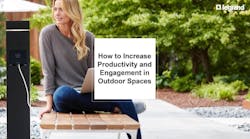It’s a beautiful day but you find yourself stuck inside, tethered to your desk – your work and productivity depend on it.
And the reality is, that even when the workday ends, it’s no longer easy to fully disconnect, unplug and go outside. Now we need to be productive 24/7, but outdoor spaces are rarely supportive of that need according to Sabrina Snyder, product marketing manager for Legrand, a digital and electrical solutions provider.
Beyond Outdoor Spaces ► 4 Office Must-Haves for Employee Wellness
“As Americans, roughly 90 percent of our time is spent indoors,” Snyder explains. “In addition to that, of the remaining 10 percent only seven percent is really spent outside. The other three percent is spent in cars getting to and from home and job.”
To counterbalance this inside time, biophilic design has made strides connecting humans and nature by incorporating more plants and greenery into places where people live and work. Through studies and research, this connection has proven essential for health and well-being and has shown to have innumerable other benefits.
Inspired by these benefits, designers and their clients are taking the movement a step further, creating spaces that allow people to be outside, with nature, yet remain connected and productive. Snyder explores the whys and ways companies are creating these spaces in a webinar, How to Increase Productivity and Engagement in Outdoor Spaces.
What Do We Want in Outdoor Spaces and Why?
There are other influences, aside from biophilic benefits, that are challenging the traditional workspace model, such as a generational shift and advancements in technology. Considering these factors, there are typically three main features people are looking for in a productive outdoor space.
Mobility: One essential element is mobility, or being able to bring devices (phones, laptops, wearables, tablets and even audio-visual equipment) outdoors, and move from space to space freely without interrupted connectivity.
“That’s a huge, disruptive change to work places, given millennials’ desire for flexible workspaces and flexible work schedules as well as their need for constant connection,” she says. It’s not only millennials driving this change, however, all generations rely on connectivity, so mobility becomes a critical component of any space.
Flexibility: It’s important that these spaces lend themselves to a variety of activities, such as enhancing collaboration, optimizing downtime and creating a more productive and more engaged population. This often means having spaces that can serve as both individual and group workspaces.
“This desire for flexible spaces, especially flexible work spaces, encompasses multiple generations. This is about spaces that don’t just have picnic tables to ‘encourage work outdoors’ – instead they have actual collaboration or meeting areas. They’ve thought through things like shading, lighting and power access,” Snyder says.
Functionality: These spaces need to support our habits and have all the conveniences of the indoors, while still providing the much-needed access to nature or a comfortable, enjoyable environment.
“Gone are the days when employees logged off their PCs at five o’clock and went home,” Snyder says. “For better or worse we are now connected and we’re productive all of the time. But we’re not just working from home and office, we’re also working from what’s been called third spaces. These are areas that are between work and home and allow you to be productive yet still enjoy other aspects of your environment.”
What to Consider When Creating Outdoor Spaces
A common thread that runs through the concept of creating productive outdoor spaces is the need for intentional design.
“It’s not as easy as buying a property that has some green space and calling it a day. We really need to think about how you can make those green spaces or outdoor spaces perform better,” Snyder says.
Without being strategic you run the risk of having to retrofit a space with additional electrical outlets and equipment, after the fact, which can be both unsightly and unsafe.
Also, consider location and who will be using the space. Whether it’s education or hospitality and retail, healthcare or in a commercial office building, goals will be unique to each setting and achieving them will take a strategic and intentional design strategy.
For instance, in commercial applications one goal will be to improve employee productivity, whereas in a hospitality or retail setting it’s important to encourage people to stay longer.
“The more people that can use their devices and power up, the more likely they are to spend more and stay longer in that location,” Snyder says. “Malls have Wi-Fi and convenience power outlets today for exactly that reason and there’s no reason why that shouldn’t be implemented in outdoor spaces as well.”
Finally, consider the climatological conditions. This will play a major part in choosing equipment and furnishings that are both sustainable and durable enough to hold up to the elements.
For more information on the benefits of outdoors spaces, and for examples and case studies listen to the full How to Increase Productivity and Engagement in Outdoor Spaces webinar.



